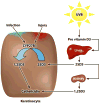Antimicrobial peptides and the skin immune defense system
- PMID: 18439663
- PMCID: PMC2639779
- DOI: 10.1016/j.jaci.2008.03.027
Antimicrobial peptides and the skin immune defense system
Abstract
Our skin is constantly challenged by microbes but is rarely infected. Cutaneous production of antimicrobial peptides (AMPs) is a primary system for protection, and expression of some AMPs further increases in response to microbial invasion. Cathelicidins are unique AMPs that protect the skin through 2 distinct pathways: (1) direct antimicrobial activity and (2) initiation of a host response resulting in cytokine release, inflammation, angiogenesis, and reepithelialization. Cathelicidin dysfunction emerges as a central factor in the pathogenesis of several cutaneous diseases, including atopic dermatitis, in which cathelicidin is suppressed; rosacea, in which cathelicidin peptides are abnormally processed to forms that induce inflammation; and psoriasis, in which cathelicidin peptide converts self-DNA to a potent stimulus in an autoinflammatory cascade. Recent work identified vitamin D3 as a major factor involved in the regulation of cathelicidin. Therapies targeting control of cathelicidin and other AMPs might provide new approaches in the management of infectious and inflammatory skin diseases.
Conflict of interest statement
Disclosure of potential conflict of interest: The authors have declared that they have no conflict of interest.
Figures


Republished in
-
Antimicrobial peptides and the skin immune defense system.J Allergy Clin Immunol. 2009 Sep;124(3 Suppl 2):R13-8. doi: 10.1016/j.jaci.2009.07.014. J Allergy Clin Immunol. 2009. PMID: 19720207
References
-
- Braff MH, Bardan A, Nizet V, Gallo RL. Cutaneous defense mechanisms by antimicrobial peptides. J Invest Dermatol. 2005;125:9–13. - PubMed
-
- Schauber J, Gallo RL. Expanding the roles of antimicrobial peptides in skin: alarming and arming keratinocytes. J Invest Dermatol. 2007;127:510–2. - PubMed
-
- Di Nardo A, Vitiello A, Gallo RL. Cutting edge: mast cell antimicrobial activity is mediated by expression of cathelicidin antimicrobial peptide. J Immunol. 2003;170:2274–8. - PubMed
Publication types
MeSH terms
Substances
Grants and funding
LinkOut - more resources
Full Text Sources
Other Literature Sources
Medical

